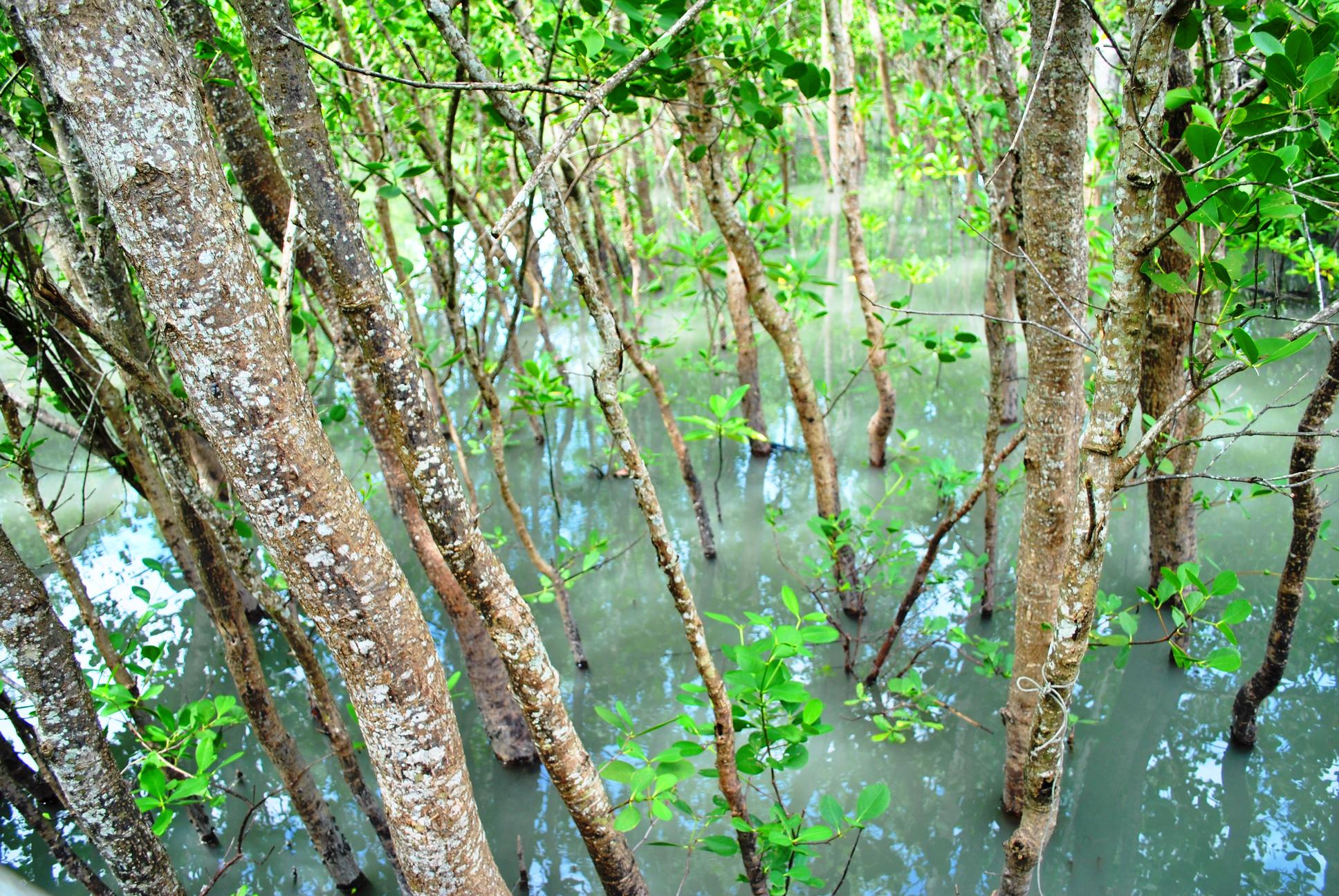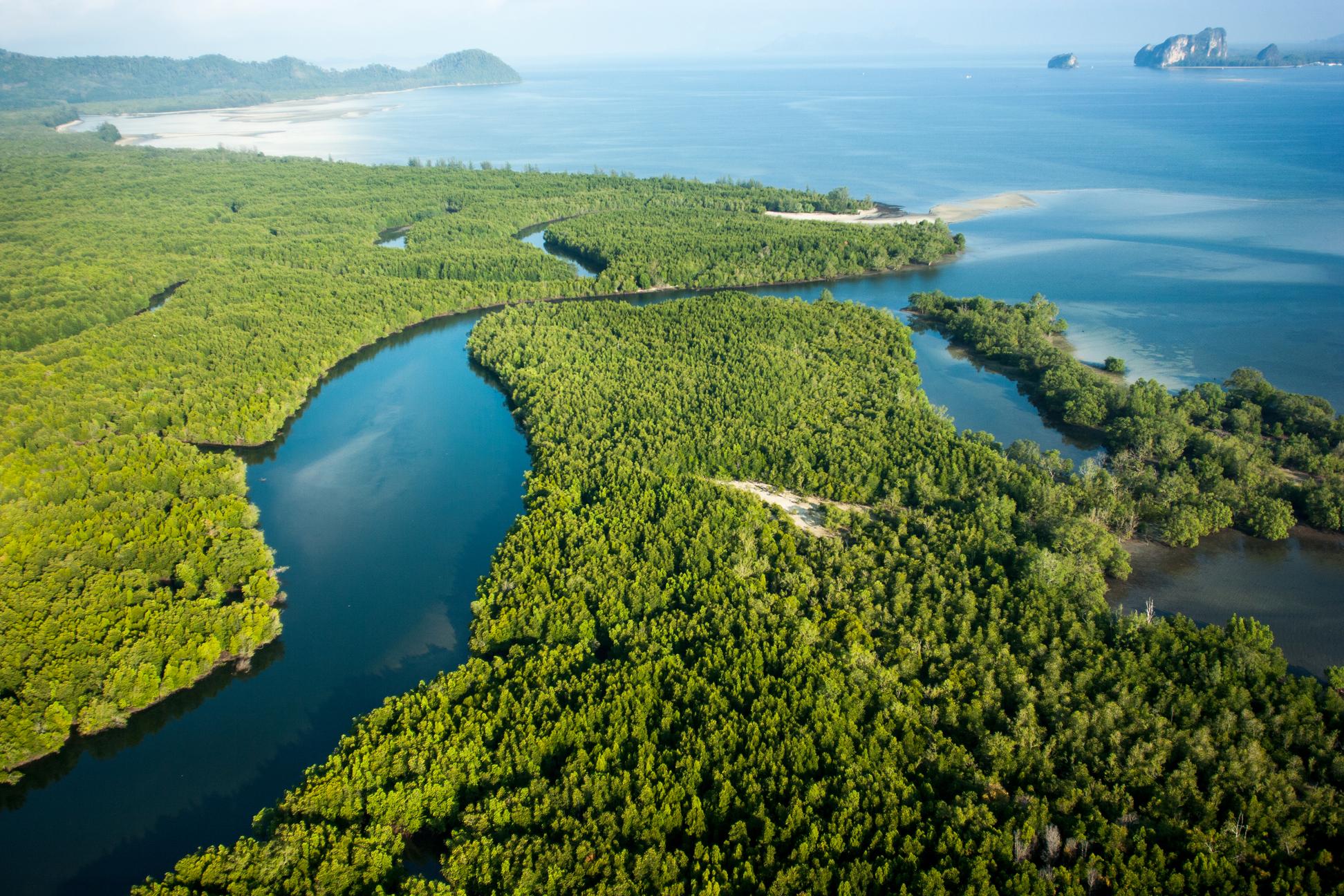
These unique trees lead tough lives, but we’re all the better for it.
What are mangroves? Mangroves are tropical trees that thrive in conditions most timber could never tolerate — salty, coastal waters, and the interminable ebb and flow of the tide. With the ability to store vast amounts of carbon, mangrove forests are key weapons in the fight against climate change, but they are under threat worldwide. By protecting mangroves, we can help protect the future of our planet.
Share these facts about mangroves:
Mangroves can be a bit salty
Unlike most trees, mangroves can grow directly in salty or brackish water.1 Their strategies for dealing with otherwise toxic levels of salinity vary — some species secrete salt after it is absorbed, while others filter out salt from the surrounding seawater.2
Mangroves come in a variety of sizes
Though estimates vary, there are at least 50 — and maybe as many as 80 — mangrove species, ranging in height from small shrubs to trees that stand 40 meters above the water, but all species thrive in low-oxygen, high-saline coastal environments.3,4
Fish flock to mangroves
Mangroves, specifically the underwater habitat their roots provide, offer critical nursing environments for juveniles of many marine species, from tiny gobies to massive crocodiles.5
Mangroves live on the edge
Mangrove forests can be found on the saltwater coasts of more than 100 tropical and subtropical countries, totaling more than 140,000 square kilometers (54,000 square miles)6 — roughly the size of Greece or Arkansas.
Indonesia tops the worldwide list
The largest amount of mangrove coverage can be found in Indonesia, where mangrove trees cover some 31,000 square kilometers (about 12,000 square miles)7 — that’s more than twice the size of Jamaica or roughly the size of Maryland.
Florida mangroves prefer the southern coast
The United States has roughly 2,000 square kilometers (about 800 square miles) of mangroves7 — an area about four-fifths the size of Luxembourg — located almost entirely in southern Florida.

Mangroves have (carbon) hoarding issues
In a single square mile, blue carbon ecosystems like mangroves hold as much carbon as the annual emissions of 90,000 cars8, making them a critical solution in the fight against climate change.
Mangroves can help keep people safe
Mangrove forests — specifically, their thick, impenetrable roots — are vital to shoreline communities as natural buffers against storm surges9, an increasing threat in a changing global climate with rising sea levels.
There’s trouble in Myanmar
Mangroves are under threat nearly everywhere, but the problem is particularly acute in Myanmar, where one study estimated10 the mangrove loss rate is more than five times the global average.
Shrimping is a jumbo problem
In Thailand, Mexico and Indonesia, mangroves are often cut down to make room for temporary shrimp pens. But once the pens have been removed, the accumulated biowaste renders the water too toxic for most forms of life.3
It’s better to revitalize than replant
Mangroves’ dense root systems inhibit the flow of tidal water and encourage the deposition of nutrient-rich sediments. But once lost, mangroves are very difficult to replant due to shifts in the very sediments the roots helped keep in place.11
Related content
References
- Somma, Marina. Trees That Grow in Saltwater sciencing.com, https://sciencing.com/trees-that-grow-in-saltwater-13429031.html. 21 September 2022.
- Lim, K., Murphy, D., Morgany, T., Sivasothi, N., Ng, P., Soong, B. C., Tan, H., Tan, K. S., Tan, T. K., (2001). A Guide to Mangroves of Singapore. Raffles Museum of Biodiversity Research, The National University of Singapore & The Singapore Science Centre. http://mangrove.nus.edu.sg/guidebooks/text/1042.htm
- Feller, C. (Ed.). Smithsonian. (2018, April). Mangroves. https://ocean.si.edu/ocean-life/plants-algae/mangroves
- NOAA. (2021, March 25). What is a mangrove forest? National Ocean Service website. https://oceanservice.noaa.gov/facts/mangroves.html
- Florida Museum. (2020, November 27). Mangrove Life. https://www.floridamuseum.ufl.edu/southflorida/habitats/mangroves/mangrove-life/
- FAO. 2020. Global Forest Resources Assessment 2020: Main report. Rome. https://www.fao.org/documents/card/en/c/ca9825en
- Beys-da-Silva, W. O., Santi, L., & Guimarães, J. A. (2014). Mangroves: A Threatened Ecosystem Under-Utilized as a Resource for Scientific Research. In Journal of Sustainable Development (Vol. 7, Issue 5). Canadian Center of Science and Education. https://doi.org/10.5539/jsd.v7n5p40
- NOAA. (2022, June 8). Coastal Blue Carbon. National Ocean Service website. https://oceanservice.noaa.gov/ecosystems/coastal-blue-carbon/
- Blankespoor, B., Dasgupta, S., & Lange, G.-M. (2016). Mangroves as a protection from storm surges in a changing climate. In Ambio (Vol. 46, Issue 4, pp. 478–491). Springer Science and Business Media LLC. https://doi.org/10.1007/s13280-016-0838-x
- Richards, D. R., & Friess, D. A. (2015). Rates and drivers of mangrove deforestation in Southeast Asia, 2000–2012. In Proceedings of the National Academy of Sciences (Vol. 113, Issue 2, pp. 344–349). Proceedings of the National Academy of Sciences. https://doi.org/10.1073/pnas.1510272113
- Waters, H. Smithsonian. (2016, December). Mangrove Restoration: Letting Mother Nature Do The Work. https://ocean.si.edu/ocean-life/plants-algae/mangrove-restoration-letting-mother-nature-do-work